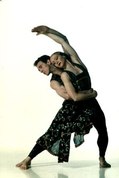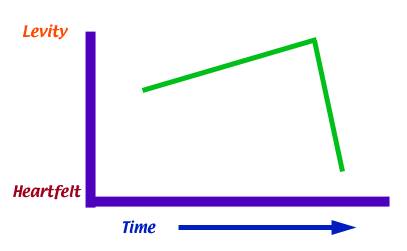|
 |
|
|
 |
 |
Paul Taylor Dance Company - Cascade, Last Look, Dream GirlsReview by Robert Abrams
March 8, 2003 Cascade includes music by Johann Sebastian Bach, choreography by Paul Taylor, set and costumes by Santo Loquasto, and lighting by Jennifer Tipton. The cast featured Patrick Corbin, Lisa Viola, Richard Chen See, Kristi Egtvedt, Silvia Nevjinsky, Andy LeBeau, Takehiro Ueyama, Heather Berest, Michael Trusnovec, Amy Young, Robert Kleinendorst and Michelle Fleet. The work was first performed in 1999. Paul Taylor has a reputation for dances that defy, or at least span, categorization. All of Paul Taylor's dancers are classically trained, yet the company's literature refers to themselves as modern. Cascade establishes one end of this span. It might be most accurately categorized as ballet without shoes. The style of the dance is very graceful, but the presentation is modern. The dancers stepped onto the stage like ballerinas often do, but with bare feet. This is an abstract work with no story. There were numerous well done elements, including gliding through the air, pairs of dancers who fit together nicely, and some appealing offset parallel sections. Cascade is a flowing, fast-paced dance. The costumes were tapestry inspired, perhaps by the floral detailing seen in the Unicorn series at the Cloisters. The women wore extended cape like skirts which allowed their legs to be seen while also amplifying their movements. While there were solos and duets in this work, the overall impression was of a well-balanced ensemble. 
Dancers: Kristi Egtvedt and Andy Lebeau
Photo by Lois Greenfield
Last Look includes music by Donald York, choreography by Paul Taylor, set and costumes by Alex Katz and lighting by Jennifer Tipton. The cast featured Michael Trusnovec, Kristi Egtvedt, Lisa Viola, Richard Chen See, Silvia Nevjinsky, Andy LeBeau, Takehiro Ueyama, Heather Berest and Annmaria Mazzini. The work was first performed in 1985. This work is on the other end of Paul Taylor's span. It is clearly a modern work. It is out there on the edge. On the edge of what, though, is open to each audience member's interpretation. Through the dancers and mirrors on stage, one can see into the dancers', and perhaps one's own, condition. The following is my diagnosis. Last Look starts by bringing the lights up on what appears to be a large pile of pillows, which then unfolds and transforms into the ensemble of dancers. The dancers exhibit stillness followed by agitated movement. This pattern was observed repeatedly. There was much agonized angularity. What I observed was clearly indicative of a dark and troubled mood: what people really feel like as they get dressed in the morning. You want to speak? I see that you are going to deny this, yes? Admitting that this is a fair representation of our lives is the first step towards recovery. The dancers also exhibited coping strategies. This is good, in principle, but I question some of their choices. They were tossing a woman around from one group of dancers to another. True, they did not ever drop her, but we are dignified, respectable people, no? As adults, we need to put circuses and cheerleading behind us. I will say, though, that I found the dancers' other coping strategy very intriguing. A group of dancers carried a woman around upside down, presumably to help the blood rush to her head. This appeared to have had a salutary effect. We should schedule future sessions to discuss this in depth. Even with this innovative morning ritual, the dancers seemed to be always fighting against sleep. Each dancer seemed incomplete by themselves. They struggled to complete the art form, to reassemble themselves into the pillow. Now, now, do not blame the pillow for engulfing you. Pillows are inanimate objects and thus have no action. The dancers, in fact, seemed to display some desperation to be a part of the pillow. What is the solution to this condition you see reflected in the dance? I am a psychoanalyst, so I am not going to give you any practical advice, other than to recommend that you view these images several more times and tell me how they make you feel during our next session. Dream Girls includes barbershop quartet songs sung by The Buffalo Bills, choreography by Paul Taylor, set and costumes by Santo Loquasto, and lighting by Jennifer Tipton. The cast featured Patrick Corbin, Lisa Viola, Kristi Egtvedt, Michael Trusnovec, Annmaria Mazzini, Orion Duckstein, Amy Young, Robert Kleinendorst and Julie Tice. This was the New York premiere of this work. This was a ballet that doesn't take itself seriously. The barbershop quartet songs were a set of musical jokes. These were integrated into a series of hilarious visual jokes that make good use of the dancers' fine movement training. Whether they were dancing with jugs of moonshine on her chest, or one pant leg that was twice as long as the dancer, they were having a good time laughing at themselves. (If Mr. Taylor wanted to play with this work further, he might try having a live barbershop quartet on stage. Even as is, though, this was a wonderful work.) In some ways, it was like David Parson's Too Many Cooks in terms of broad physical humor. What I especially liked about Dream Girls was the macro-structure. The scenes showed a slow rise in levity, followed by one final number that was extremely tender, serious, and heartfelt. 
A diagram showing Dream Girls' macro-structure.Paul Taylor showed that he is a choreographer who understands how to craft an extended work that is both visually interesting in its parts and coherent in its whole.
|
|
|



